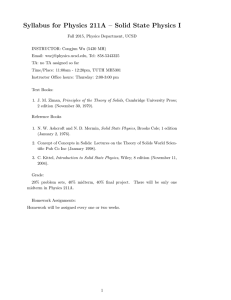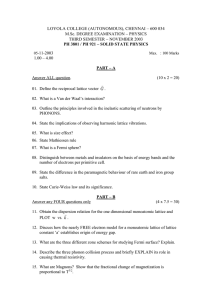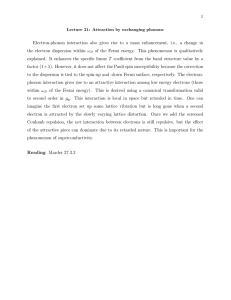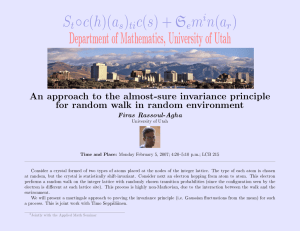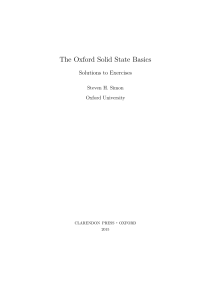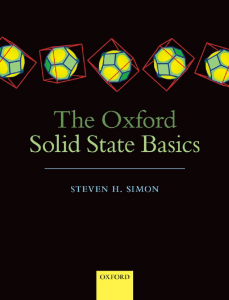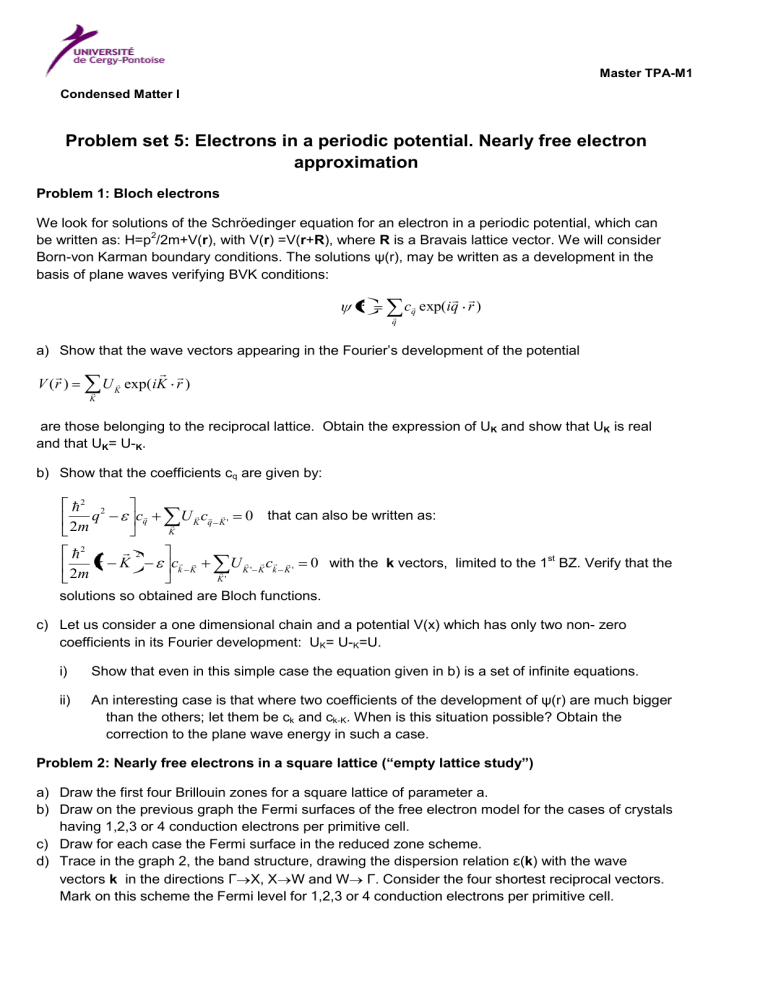
Master TPA-M1 Condensed Matter I Problem set 5: Electrons in a periodic potential. Nearly free electron approximation Problem 1: Bloch electrons We look for solutions of the Schröedinger equation for an electron in a periodic potential, which can be written as: H=p2/2m+V(r), with V(r) =V(r+R), where R is a Bravais lattice vector. We will consider Born-von Karman boundary conditions. The solutions ψ(r), may be written as a development in the basis of plane waves verifying BVK conditions: r q cq exp(iq r ) a) Show that the wave vectors appearing in the Fourier’s development of the potential V (r ) K U K exp( iK r ) are those belonging to the reciprocal lattice. Obtain the expression of UK and show that UK is real and that UK= U-K. b) Show that the coefficients cq are given by: 2 2 q 2m 2 k K 2m cq 2 K U K cq ck K K' K' 0 that can also be written as: U K ' K ck K' 0 with the k vectors, limited to the 1st BZ. Verify that the solutions so obtained are Bloch functions. c) Let us consider a one dimensional chain and a potential V(x) which has only two non- zero coefficients in its Fourier development: UK= U-K=U. i) Show that even in this simple case the equation given in b) is a set of infinite equations. ii) An interesting case is that where two coefficients of the development of ψ(r) are much bigger than the others; let them be ck and ck-K. When is this situation possible? Obtain the correction to the plane wave energy in such a case. Problem 2: Nearly free electrons in a square lattice (“empty lattice study”) a) Draw the first four Brillouin zones for a square lattice of parameter a. b) Draw on the previous graph the Fermi surfaces of the free electron model for the cases of crystals having 1,2,3 or 4 conduction electrons per primitive cell. c) Draw for each case the Fermi surface in the reduced zone scheme. d) Trace in the graph 2, the band structure, drawing the dispersion relation ε(k) with the wave vectors k in the directions Γ X, X W and W Γ. Consider the four shortest reciprocal vectors. Mark on this scheme the Fermi level for 1,2,3 or 4 conduction electrons per primitive cell. ε(k) ky Graph 1 W X Graph 2 kx X W kx, ky Problem 3: Nearly free electrons in a square lattice, corrections to the free electron energy. ky We will study a two dimensional solid of surface S, crystallizing in the square structure of parameter a. The potential V(x,y) is a small perturbation to the kinetic energy term H0=p2/2m and has the symmetry properties related to the crystal structure: V(x, y) = V(x + a, y) = V(x, y + a) = V(y, x) = V(-x, y) = V(x, -y). We note the eigenstates of H0 |k>0 , so that : H0 |k>0= ε0 (k) |k>0. a) Write the general expression of the vectors g belonging to the reciprocal lattice and trace the limits of the 1st Brillouin zone. Show that the potential may be written as V (r ) b) g wg exp(ig r ) and find the coefficients wg as a function of V(r). Prove that wg is real and that wg= w-g. Using perturbation theory of non degenerated levels obtain ε1(k), the first order correction to the energy of the free electron. Show that it only depends on w0. d) Show that in the same conditions, the second order correction ε2(k) is: c) 2 (k ) g 0 ( k ) 0 wg2 ( k 0 g) e) Explain why the previous expression is not valuable anymore when k has its extremity in the border of the 1st Brillouin zone f) Let k1 be the vector of coordinates ( /a, - /a). Show that ε0(k1) is a four-fold degenerated level : = ε0 (k1+gj) for j = 1, 2, 3. List the 3 vectors gj involved. Show that two of them are orthogonal. Let us call them g1 and g2. Using the symmetries of the potential show that wg1 = wg2 0(k1) and wg3 = wg2-g1. g) We admit that the perturbation to the level 0(k1) caused by the potential V, may be calculated to the lowest order by assuming that the perturbed eigenstate is the linear combination: k1 0 k1 3 0 j 1 j k1 gj where j are constants. We are looking for the perturbed energies ε. Write the secular equation verified by ε, supposing for simplicity that w0=0 and calling wg1 = wg2=w and w' = wg3. Verify that the solutions are: ( k w' and 0 1) ( k w' 2w 0 1)
